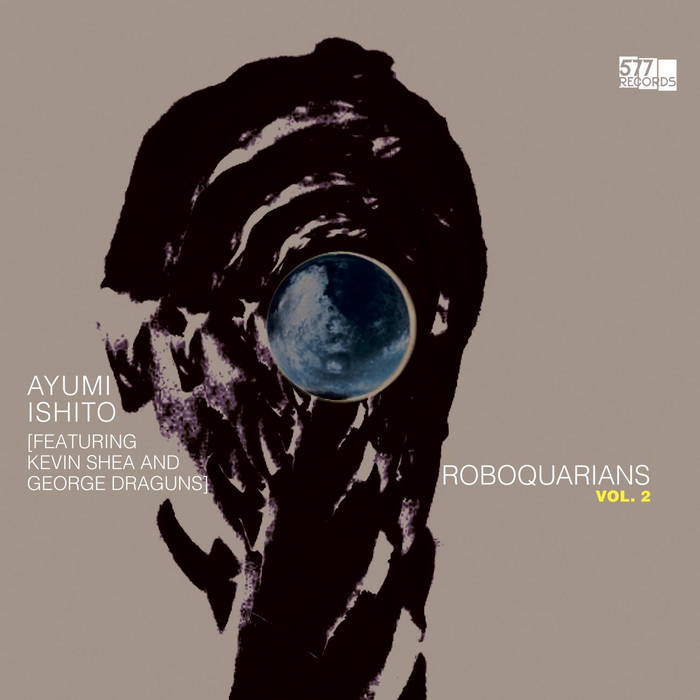Japanese-born, New York-based saxophonist Ayumi Ishito recorded her debut album View From A Little Cave in 2016. Almost a decade later, her artistic voice and skronking jazz rock style have remained refreshingly potent, lending credence to the epithet of ‘up-and-coming sax talent’ bestowed upon her by 577 Records. While Ishito has slowly become a mainstay of the label’s catalogue, frequently featuring both as a leader and sidewoman, the past year was especially fruitful. Roboquarians, Vol. 2 promises to continue this hot streak.
Wondercult Club, the third album by her quintet with guitarists Hajime Yoshida and Yana Davydova, bassist Yoshiki Yamada, and drummer Carter Bales, swung between seriously grooving jazz rock and funky harmolodics. Ishito’s effects-laden, ripping-then-flowing lines gave vibrant colour to the impressionistic avant jazz aquarelle of Open Question, Vol. 2 – one of 577 founder Daniel Carter’s many projects. Crucially, Roboquarians, Vol. 1 pushed her in a new, more hectic and whimsical avant punk direction in collaboration with drummer Kevin Shea and guitarist George Draguns.
According to the label, it was Shea and Draguns who reached out to Ishito to salvage what they could from a previous iteration of the project. Yet, the trio’s music belongs as much to Ishito as it does to them. Curiously enough, the second Roboquarians volume is actually the trio’s earliest recorded encounter, captured a year before the first volume. Although this knowledge makes it tempting to call Vol. 2 rawer, more aggressive, or even unrefined, both volumes share a cohesive and consistent aesthetic. The minute shifts and in-the-moment decisions – rather than any overarching evolution – push the collective from frantic shredding into headier spaces.
In one of these key moments, Shea becomes the star on opener ‘Aromatherapy For Erzulie’. His snare and cymbal hits skitter and slide like a cigarette between the fidgeting fingers of a recovering nicotine addict, imparting the cut with a similarly edgy and nervous character. A stalwart of NYC’s creative music scene, Shea brings to the table a devilish playfulness usually nourished by his other bands like Mostly Other People Do The Killing and Talibam! Meanwhile, his colleagues try to keep up. Draguns lays down a calming cumbia-evoking groove, momentarily transporting us under the palm trees of some tropical beach, only for Ishito to wake us up with a blaring alarm. Her saxophone rarely sounds like a saxophone here, instead mimicking everything from recorders to analogue synthesisers and wah-wahs, the choice of effects as important as the chords she’s playing.
While the opening cut is decidedly jazz rock but filtered via the DIY punk ethos of Blurt, Minutemen and NoMeansNo (sans vocals) rather than Mahavishnu Orchestra, the remaining three tracks veer closer to classic fusion interpreted through a contemporary lens, not too far removed from The Messthetics and James Brandon Lewis.
Like The Messthetics, Draguns’s background is in hardcore, a trait which can be felt throughout the album, but in particular on ‘False Positive’. As things calm down, his scorched fretwork is pushed into the limelight, the guitar’s elongated licks shimmering with a particularly gnarly growl. Still stubbornly hyperactive, Shea’s lines are ruly enough to form a background texture, while you could easily mistake Ishito’s filtered, mangled saxophone for Bill Laswell’s dubby electric bass sound.
‘Poison Darts’ ramps things up again, but instead of retracing its steps back into punk, it lunges forward into full-on psychedelia as disorienting riffs and rumbling percussion wriggle around the stereo image. The closer ‘Con-Fusion’ then goes absolutely mental. The three musicians stumble over each other with ever wilder expressions, until they conjure a Richard Pinhas-esque explosion of freely improvised noise rock. Screaming guitar riffs ricochet off each other. Scrunching, overblown saxophone lines (that again rarely sound anything like a saxophone) run for their lives. Drum patterns in full nervous breakdown mode fracture and shatter into a thousand pieces. Rambunctious fun that closes the album with a proper bang.


